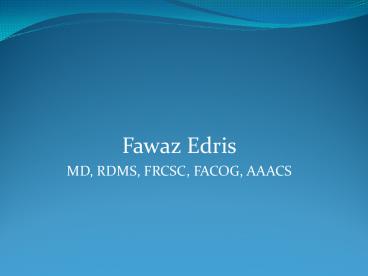Chronic Pelvic Pain PowerPoint PPT Presentation
1 / 17
Title: Chronic Pelvic Pain
1
Chronic Pelvic Pain
- Fawaz Edris
- MD, RDMS, FRCSC, FACOG, AAACS
2
Introduction
- Non cyclical uterine or non-uterine pelvic pain gt
6/12 - Gynecological
- GIT
- Urological
- Orthopedic
- Musculoskeletal
- superficial (nerve entrapment, hernia,
referred) - Psychological (by exclusion)
3
Introduction
- Somatic pain
- Visceral pain
- Diffusely spread
- Lack of well defined areas in the sensory cortex
- Viscerosomatic convergence
- No neurons in the spinal cord receives only
visceral pain - Viscerosomatic neurons
- Larger receptive field than somatic
- Less numbers than somatic
4
History
- Pain history and its components
- Relationship to period, bowel movement,
urination, intercourse and activity - Previous episodes
- Other symptoms (GIT, urological, weight loss,
etc) - Effect on life (social, work, family)
- Relationship of onset to events (newly married,
rape, lifting, chest infection, etc) - Hx of sexual, physical, or emotional abuse
- What medication used
- What investigations done
- Other stress or psychological symptoms
(depression, anxiety, etc) BUT! - Secondary gain (off work, husband to stay,
attention, etc) BUT! - Full Gyn Hx (STD, PID, Infertility, dysparunia,
surgeries including DC, etc.) - Full surgical Hx
- Medical Hx (IBS, IC, IBD)
5
Examination
- Abdominal (point, superficial, deep)
- Pelvic (tenderness, mobility, nodularity)
- Nerve entrapment
- Dermatomes
- Head raising
6
Investigations
- Limited use
- Scopes if symptoms suggest (GIT, Urological)
- Imaging if symptoms suggest musculoskeletal
- U/S although of limited use
- Laparoscopy the ultimate but last method
- Psychological evaluation
7
Gynecological
- Endometriosis (30)
- Pathogenesis
- 20-30 missed on laparoscopy
- Treatment is medical (may start before Dx)
- Cont. OCP
- Depot Provera
- Danzol
- GnRH analouge add back therapy
- If no response, surgical (TAH / TAHBSO)
- Size and location doesnt correlate with pain
- Path0physiology of pain not well understood
- Infertility
- Chronic PID(25)
- Recurrent exacerbations
- Hydrosalpinges
- Adhesions !!
8
Gynecological
- Ovarian
- Cysts are ASYMPTOMATIC, unless
- Rapid distention
- Bleeding
- Torsion
- Special cysts (Endometrioma, Dermoid)
- Ovarian remnants retroperitonealy (with cyst)
- Uterine
- Adenomyosis (rarely CPP)
- Fibroid are ASYMPTOMATIC, unless
- Degeneration
- Torsion
- Prolapsed submucus fibroid
- Retroverted uterus DOSE NOT cause CPP. Maybe
dysparunia!
9
Gynecological
- Pelvic Congestion Syndrome
- Myth!
- Non specific symptoms
- No agreed upon diagnostic measures
- No agreed upon therapeutic measures
10
Non-Gynecological
- G.U.T
- Multiple examples, the most common
- Urethral syndrome
- IC
- Common 1 in 5 women
- Urgency, frequency, nocturia, CPP
- Diagnosis treatment
- G.I.T
- Multiple examples, the most common
- IBS, IBD, Hernias.
- Innervation of the lower intestinal tract, same
as uterus and fallopian tubes ? pelvic pain
11
Psychological
- 30 of CPP remains undiagnosed even after
laparoscopy - Is this a primary or secondary thing!
12
Pain Perception
- Every pain is a result of stimulus and response,
however Chronic pain ?Acute pain. - Acute pain response is appropriate to stimulus.
- Chronic pain is affected additionally by
- Patients reaction to pain
- Familys reaction to the patient and her pain
(reinforce or persistence) - So Response to a stimulus is inappropriate,
exaggerated, inaccurate, and may persist even
after the stimulus is gone
13
Management
- Therapeutic, supportive, and sympathetic
physician-patient relationship should be
established (only few can do it!) - Regular F/U rather than come back when pain
persist - The latter reinforces pain behavior
- If no pathology is found, patient should NOT be
ignored! - Reassurance symptomatic treatment
- Multidisciplinary pain clinic
14
Management
- Multidisciplinary pain clinic
- GYN, Psychologist, Anesthetist, others
- If no team is in place, use referrals.
- Psychologist
- Techniques for stress reduction, adaptive
strategies - Marital, sexual, and social counseling
15
Management
- Treat underlying cause if found!
- If none is found
- Multidisciplinary team
- NSAIDs
- Ovulatory/menstrual suppression
- Cont. OCP, Depot Provera, Danzol, GnRH analouge
add back therapy - May work for those with pain related to the
period (mid-cycle, premenstrual or menstrual) or
those with ovarian causes (ovarian remnant) - Low dose TCA (increase inhibitory neuromodulators)
16
Management
- Surgeries
- If no pathology ? NOT effective
- If no strong evidence of pathology ? thorough
psychological evaluation before any surgery - Lysis of adhesions
- NOT effective unless the site of adhesions site
of pain. - Vicious cycle
17
- Thank you

